E. Rowell: The motive of the Obama-Biden Administration to foil Israel’s ability to win the war against Hamas is clear. The sum of all their efforts on a regular basis goes to preventing Israel from completing the mission in Gaza while protecting Iran and her proxies. They want to prevent a triumphant Israel at all costs. This is unacceptable to the majority of Americans who support Israel. In addition, the efforts which they created and now support, to cultivate anti-Zionism and Jew hatred on college campuses, has led directly to the genocidal groups on campuses, threatening Jews and Israelis. This is psychological warfare against Jewish people everywhere. Now even democrat voters are disgusted with both the Pro-Palestinian rioters and this administration’s craven Jew hatred.
Mishaps and mortars and cargo and kitchens.
By J. E. Dyer, THE OPTIMISTIC CONSERVATIVE 26 April 2024
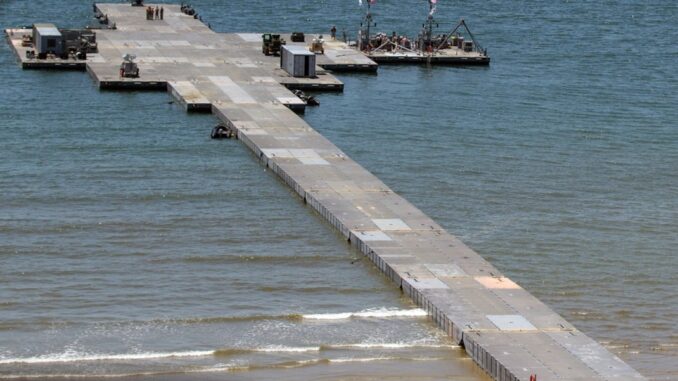
It’s tempting to place a major focus on the mishaps now besetting the U.S. temporary pier project off Gaza. But we’re going to get past that lightly, for a brief, even more important discussion of a couple of unbudging realities in the overall situation.
One is that the Biden administration continues to try to thwart Israel’s strategy for Gaza, which is to eliminate Hamas as a factor there and reset post-Hamas conditions for long-term arrangements as advantageously as possible for stability and Israeli security.
The other is that the condition of Gaza has already been altered to the extent that it cannot go back to the status quo ante (i.e., before 7 October 2023). The status quo ante is a dead letter. What Biden is trying to thwart is Israel’s strategy for shaping the new status quo. That’s what all the jockeying about Rafah, the hostages, cease fires, and what Israel is doing about Iran is about.
The temporary pier project has been kind of sad so far. As the plot develops, we learn that the plan is to install the Army pier directly adjacent to the Gaza coast. A similar Navy pier will sit further off the coast (three miles), and will become a hub for transferring cargo from cargo ships to Army support vessels (see below), which will then approach the Army pier and offload the cargo in batches to a waiting processing terminal ashore.
It wasn’t clear at the outset that both the Navy and Army apparatuses would be used (I wrote about both of them here). The apparent need to employ both of them adds a layer of complexity that would be unnecessary if the U.S.-delivered aid were simply offloaded from the cargo ships at an Israeli port and moved into Gaza over land.
The Biden priority is thus clearly to establish an offloading point in Gaza, whatever it takes. That clarifies the character of the project: it’s meant for the primary purpose of delivering aid directly by sea to Gaza, a measure that breaks the basis on which Israel’s security blockade of Gaza has been maintained since early 2009. The security blockade was compromised a few weeks ago when the World Central Kitchen (WCK) deliveries began, to a separate, hastily-constructed jetty off Gaza. Pursuing the U.S. pier and yet another stream of deliveries by sea into Gaza will compromise it further.
It apparently will take some unexpected time, however, to get the whole multi-pier contraption set up. Two Military Sealift Command (MSC) ships, USNS 1st Lt. Baldomero Lopez (T-AK-3010) and USNS 2nd Lt. John P. Bobo (TAK-3008), were carrying parts for the Navy pier from the East Coast. But Bobo suffered a fire in the engineering spaces during its transit, and had to turn around on 11 April, arriving back in Jacksonville, Florida last week.
That leaves Lopez in the Mediterranean with a collection of the Navy pier parts, and the problem of how to move Bobo’s load to marry up with it. Lopez is underway east of Crete on 26 April, on a heading toward Gaza. Without the parts John P. Bobo was carrying, the Navy pier can’t be assembled yet.
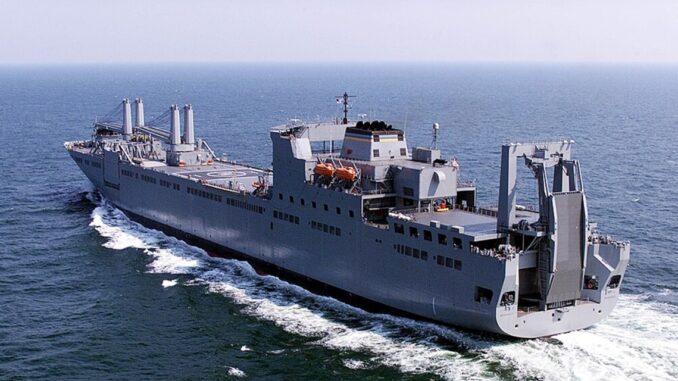 M/V Roy P Benavidez, now a ready reserve transport ship for MARAD, in MSC livery ca. 2010. Benavidez is moving parts for the U.S. Army Trident temporary pier to be operated off Gaza. Wikipedia, USN photo.
M/V Roy P Benavidez, now a ready reserve transport ship for MARAD, in MSC livery ca. 2010. Benavidez is moving parts for the U.S. Army Trident temporary pier to be operated off Gaza. Wikipedia, USN photo.
Meanwhile, M/V Roy P. Benavidez, a former MSC ship now working ready reserve transport for the U.S. Maritime Administration (MARAD), is toting Army parts and has shown up off Gaza, where work on the Army pier has begun. Unfortunately, the Army pier site took mortar fire from Hamas on Wednesday 24 April.

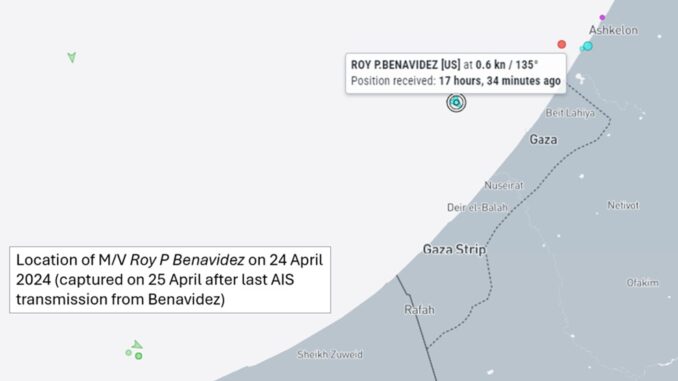
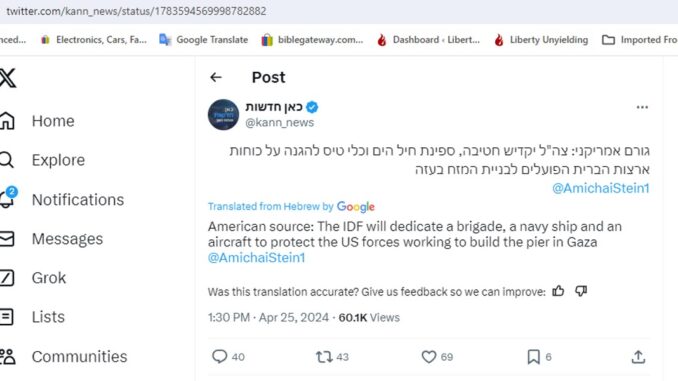
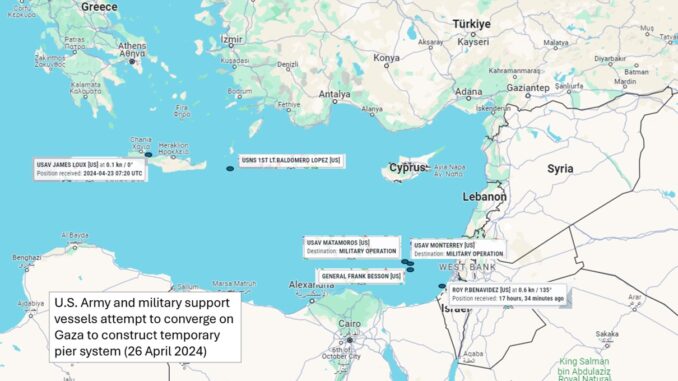


Leave a Reply
You must be logged in to post a comment.